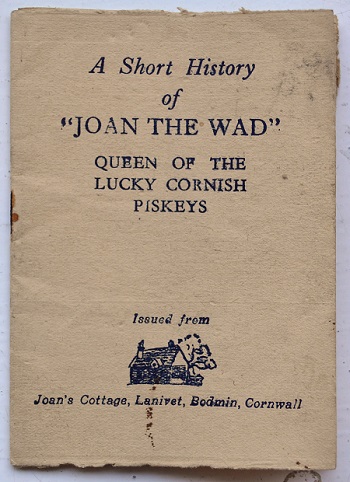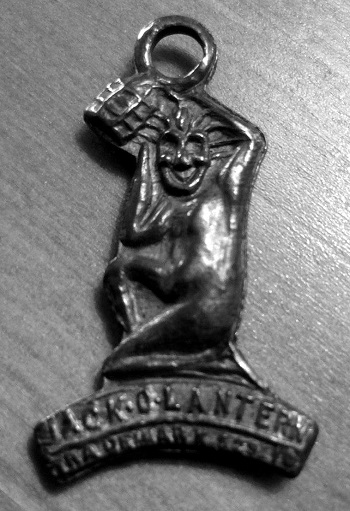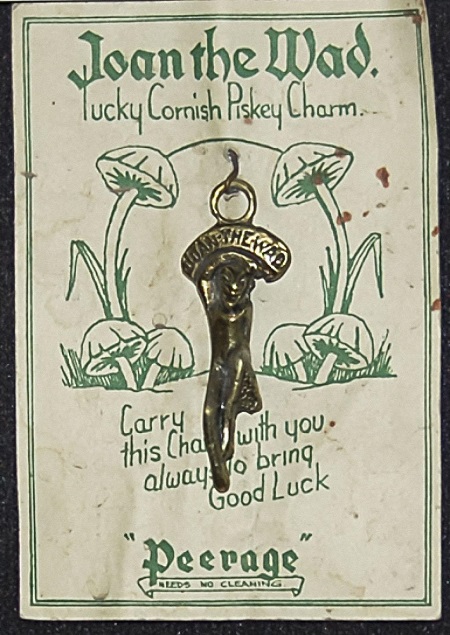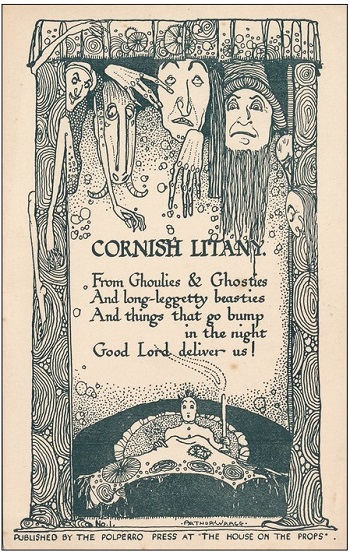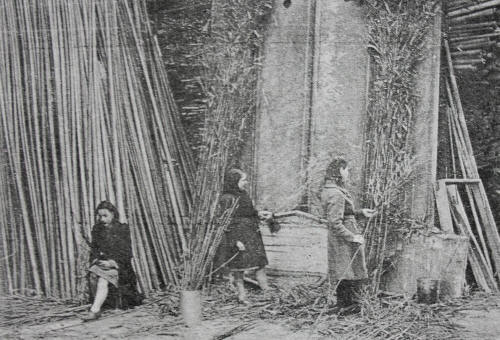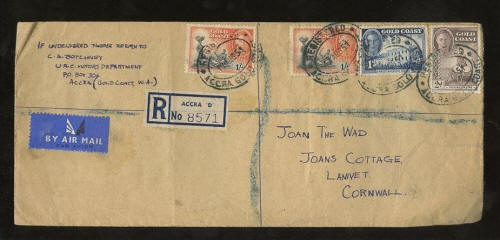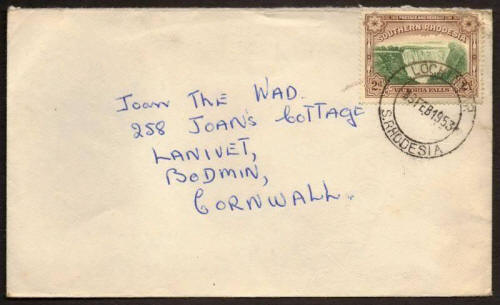|
|
| home | exhibitions | interviews | features | profiles | webprojects | archive |
|
This Charming Man: FT Nettleinghame and his piskey-empire Rupert White
In 2015, the Museum of Witchcraft and Magic received an unusual donation. A tiny booklet - the size of a child’s hand - it bore the title ‘A Short History of “Joan the Wad”’. It was published by ‘Joan’s Cottage, Lanivet’, but, with its faded paper and rusty staples, its age and its author were a mystery.
Fittingly for a book so small, it is all about Cornish piskeys and piskeylore. The opening section, for example, states: Cornwall is not merely the land of Pilchards and Craime, of Blue Seas and Sunny Skies, of Quaint Villages and Beauteous Maidens, of Love and Health. It is the Land of Giants and Piskies. It is the luckiest County in England. It has less unemployment and more health, and where will you find a Cornishman who is not firmly convinced, that this is due to the good offices of the little piskey folk with whom he makes a point of keeping on good terms? Rare indeed it is that you will find a Cornishman… who does not carry with him a metal replica of the Queen of the Piskies. It mentions Jonathan Couch, the Victorian folklorist: The Piskey folk, according to Couch’s History of Polperro, are “about a span long, clad in green, and wearing straw hats or little red caps on their heads.”’ Two only are known by name, 'Jack o the Lantern " and “Joan the Wad.” It goes on to include 6 or 7 more anecdotes about piskeys, and some small illustrations, before concluding: As we have said above, we have a collection of forty or fifty narratives from all over Cornwall relating to Piskeydom, but we cannot include them here. They can be found in our little book. " Piskeylore." price 1/-. Our purpose here is simply to interest you in these folk and their works so that you may get into touch with them. through friendship with their Queen, " Joan the Wad,“ for so long as you carry Joan the Wad with you for so long will you prosper. Alongside the piskeylore and the salesmanship, are incongruous adverts for coko matting and striped burlap made by the ‘British Bamboo Cane Company’, which are also for sale from Lanivet. In fact the whole publication appears to be a tiny brochure for a single operation that, bizarrely, sells magical piskey charms alongside various bamboo-related goods. Couch’s book on Polperro (1871), mentioned in the booklet, includes a short poem which indicates that the piskey characters had both malignant and benign aspects, with ‘wad’ (rhyming with mad) being a colloquial term for a torch or bundle of straw:
Jack-the-lantern, Joan-the-wad, Eliza Bray in ‘Peep at the Pixies’ was the first to publish a set of fairy stories specifically from Dartmoor and North Cornwall (1853). As she put it: Now this wild tract of land, as well as other parts of Devonshire and Cornwall, is considered to be haunted by a set of little creatures, called Pixies. They are not like children; for, though they are small, and can sometimes be seen, it is said they can fly as well as run, and creep through key-holes, and get into the bells of flowers, and many other places where little boys and girls cannot creep. The Pixies are sometimes good, and do kind acts; but more frequently they are mischievous, and do a great deal of harm to men, women, and children, if they have a spite against them; and often hurt the cattle.
The brass Jack ‘o’ Lantern charm distributed to the world from Joan’s Cottage, Lanivet
In one of the stories pixy lights, are, again, a feature: But scarcely had sturdy Will uttered those words, when they both saw a pale glimmering light, somewhat in the shape of a ball, of an emerald hue, not unlike the light which the glow-worm gives from her little lamp on a fine summer's night. It seemed to roll on before them."That's very strange," said the old man, "I do not half like it." "But I like it well," said Will, "and I'll follow and see what comes on 't; for, may be, 't is a Pixy light, and that never burns for nothing. I'll after it." Robert Hunt (1865) and William Bottrell (1870) who were folklorists active at the same time as Couch, produced similar, but even more comprehensive, collections of folk stories from Cornwall, partly collected from wandering droll-tellers. By the beginning of the 20th century, thanks to writers like WB Yeats and Malcolm Arnold, it had become widely accepted that, unlike the materially-minded English business man, the ‘uncorrupted’ Celt had a unique sensibility. For Evans-Wentz, writing in 1911, this helped account for the Celts’ apparently undiminished belief in fairies: If our Celtic peasant has psychical experiences, or if he sees an apparition which he calls one of the 'good people', that is to say a fairy, it is useless to try to persuade him that he is under a delusion: unlike his materialistically-minded lord, he would not attempt nor even desire to make himself believe that what he has seen he has not seen…Unlike the natural mind of the uncorrupted Celt, Arunta, or American Red Man, which is ever open to unusual psychical impressions, the mind of the business man in our great cities tends to be obsessed with business affairs both during his waking and during his dream states.
Nettlinghame’s charms were manufactured by the Peerage Brass Company in Birmingham (known prior to 1946 as Pearson-Page). Image courtesy Museum of Witchcraft.
It is interesting to speculate as to how descriptions such as these helped inform popular opinion and taste over fifty or more years, and thereby created a market for charms inspired by the Cornish piskey. Certainly, as a type of brass-ware, horse brasses, door-knockers and small statues linking piskeys back to Cornwall and Dartmoor, seem to have been produced in large quantities from the late Victorian era. However, the Joan the Wad booklet, produced several years later, is different. This is because it clearly states the case for these particular piskey-charms having additional magical, luck-giving qualities. They are not merely decorative images for, as described in Joan the Wad’s booklet: ‘Each one is dipped in the lucky Saint’s Well water’. It turns out that the man who wrote the booklet was the mastermind behind various business schemes. Biographical details for FT Nettleinghame are scanty and complicated by the difficult spelling of his surname but, based on various newspaper reports in the British Newspaper Archive, he appears to have served in the Royal Flying Corps during the First World War and to have been the author of ‘Tommy’s Tunes’, a collection of soldier’s songs published in 1918. In the early 1920’s he worked as a ‘financial organiser’ for two companies run by his father-in-law, but by 1923 he and his young wife had relocated to Cornwall. With very little money in their pockets, they set up a business based in Polperro’s ‘House of Props’ which relied largely on selling locally-made pokerwork (or pyrography) designs: In 1923 we started off with the Cornish Litany and a half dozen other texts by burning them into wood…There was, we found, a public who cried for more…this resulted in that Exquisite Imaginer, Arthur Wragg, goulieing the Cornish Litany for reproduction as a postcard, to be followed later by St Ives and various other ones (Nettleinghame, 1926).
Pokerwork (or pyrography) design, probably produced by artist Arthur Wragg himself in the 1920s.
Arthur Wragg, then aged 21, was an illustrator who according to biographer Judy Brook moved to Polperro in 1924, where he worked for the Nettleinghames in return for board and lodging. Nettleinghame started publishing postcards and books under the imprimatur of the Polperro Press. The Cornish Litany series of postcards were the most striking and memorable, and the litany itself could have been a Nettleinghame invention: certainly linking it to Cornwall probably was.
From Ghoulies and Ghosties
Cornish Litany postcard by Arthur Wragg
A number of short books followed, with reviews appearing in the press in 1927 for Polperro Proverbs, Old Cornish Carols, Polperro Privateers (by Q), and a guidebook on Marazion and St Michael’s Mount. Having apparently bought other properties in North East Cornwall, he overstretched himself, however, and in February 1931 ‘F.T. Nettleinghame, art dealer’, was declared bankrupt. He was also divorced from Lilian Maud. Writing later (1947) Nettleinghame blamed high tides and heavy rain for damaging his stock, and forcing him to relocate from Polperro.
November 1932 Kirkintilloch Herald, Scotland. This is the earliest known ad for Joan the Wad whilst still in Looe, and would have been similar to the first one placed in the Daily Express.
As an undischarged bankrupt he could not register a new business or borrow money easily. Probably for this reason, two men called Douglas Sargeant and Harry Alexander became involved with a new business idea: selling charms. On March 2nd 1932, Nettleinghame registered ‘Joan the Wad’ and ‘Jack o Lantern’ as trademarks, and, now based in Looe, he placed an ad in the Daily Express for a cost of £6. By his own account, the response was overwhelming, and more and more adverts were placed, and piskey charms were sold all over the UK and further afield. Nettleinghame’s new business grew rapidly into a kind of piskey-kingdom or empire: I had 80 indoor staff and 40 outworkers. We ran a chain of shops in Devon and Cornwall (sometimes as many as three in one town). By this time we were spending £30,000 per annum in publicity…(Nettleinghame, 1947). In 1934 business partner Douglas Sargeant sought damages from a newspaper that had described him and his involvement with Joan the Wad as dishonest. In the course of the proceedings he admitted: ‘The charms are manufactured in Birmingham and then they are taken to Cornwall and dipped in a certain well’. That same year Nettleinghame moved to St Benet's Abbey in Lanivet near Bodmin with a new wife, Marion, by which time he was investing proportionally less in the charms business: we still had income coming in from ‘goodwill’. And this income we spent consistently and at great velocity in developing the St Benet's Abbey estate in two separate occupations. One a roadhouse and the other a nursery. The nursery evolved into a successful bamboo-growing business which was up and running by the outbreak of war, but even after the move to Lanivet, Nettleinghame continued to promote Joan the Wad in order to reach more lucky customers all over the world.
Workers in the bamboo factory, Lanivet.
Interestingly artist-occultist Ithell Colquhoun mentions St Benet's in her much-loved book on Cornwall ‘The Living Stones’, published in 1957. Colquhoun’s account of Nettleinghame is as follows: (He) advertised widely in the press particularly in popular ‘occult’ magazines, with an impressive array of testimonials from satisfied customers claiming that their luck had changed dramatically once they possessed ‘Joan the Wad,’ ‘who sees all, hears all, does all.’ The small metal figure…represented her as an elf - the conventional Cornish ‘piskey’ who appears on many objects offered for sale to tourists; Vulgarised now as a ‘souvenir,’ this image may yet perpetuate some genuine tradition about the look of the ‘small folk.’ But was ‘Joan the Wad’ a piskey at all? She may have been all too human, a witch who could cast spells for good or ill. ‘Joan,’ as Professor Margaret Murray has shown, was a favourite name among the witch-covens.
Joan the Wad ad (1947) in ‘New Frontiers’ an early sci-fi magazine. These are the ads that Ithell Colquhoun describes in her book ‘The Living Stones’
Colquhoun, who was an astute observer of such matters, implies that Nettleinghame’s Cornish venture prompted a number of copy-cat businesses, and something of a craze for charms in the late 1950s: St. Bennet’s is empty again, and Joan is now distributed from Polperro, whence also hails ‘Glama, the oriental charm of luck and love.’ When Joan appeared at Lanivet some years ago, she seemed to be the only luck-bringer of this type in the field; but she heralded a bevy of others, and now besides Glama, there is Lady Luck, the Lucky Seroom, Beppo’s Little Man, the Horn of Plenty and the Wheel of Life, not to mention such die-hards as the Rabbit’s Foot and the Four-leaved Clover to choose from, most of them with a ‘legend’ or ‘history’ thrown in, for about the same price as Joan. The enchanting little Joan the Wad booklet now in the MOWM collection would therefore seem to have been written by FT Nettleinghame, and to date from the late 40’s. It is not known for precisely how long the business continued after this time, but stamped envelopes recently for sale on Ebay indicate evidence of continuing world-wide interest in the Lanivet-based business - particularly from Africa - until at least 1953. Given Colqhoun’s book was published in 1957, it seems Nettlinghame quit the abbey, and returned to Polperro in the mid 50s - though at some point, as he was around retirement age, he would have sold the business on. Certainly, even now (2018), the Joan the Wad shop in Polperro with links back to Nettinghame’s own remarkable ‘piskey empire’ of the 1940s, continues to flourish.
A letter from the Gold Coast dated 1951.
Southern Rhodesia 1953. We can assume this was a postal order requesting a lucky charm by return of post.
References Bottrell William (1870) Traditions and Hearthside Stories of West Cornwall Bottrell, Penzance Bray, Mrs (1854) A Peep at the Pixies (or Legends of the West) Grant & Griffith London Colquhoun, Ithell (1957) The Living Stones Peter Owen Couch, Jonathan (1871) A History of Polperro W. Lake, Truro Evans-Wentz WY (1911) The Fairy Faith in Celtic Countries Henry Frowde Hunt, Robert (1865) Popular Romances of the West of England John Hotten Nettleingham, FT (1917) Tommy’s Tunes Erskine Macdonald Nettleinghame, FT (1926) Polperro Proverbs and Others Polperro Press Nettleinghame, FT (1948) The Romance of a New Cornish Industry British Bamboo Cane Company
Originally published in 'The Enquiring Eye: Journal of the Museum of Witchcraft and Magic' (2017) |
|
|

